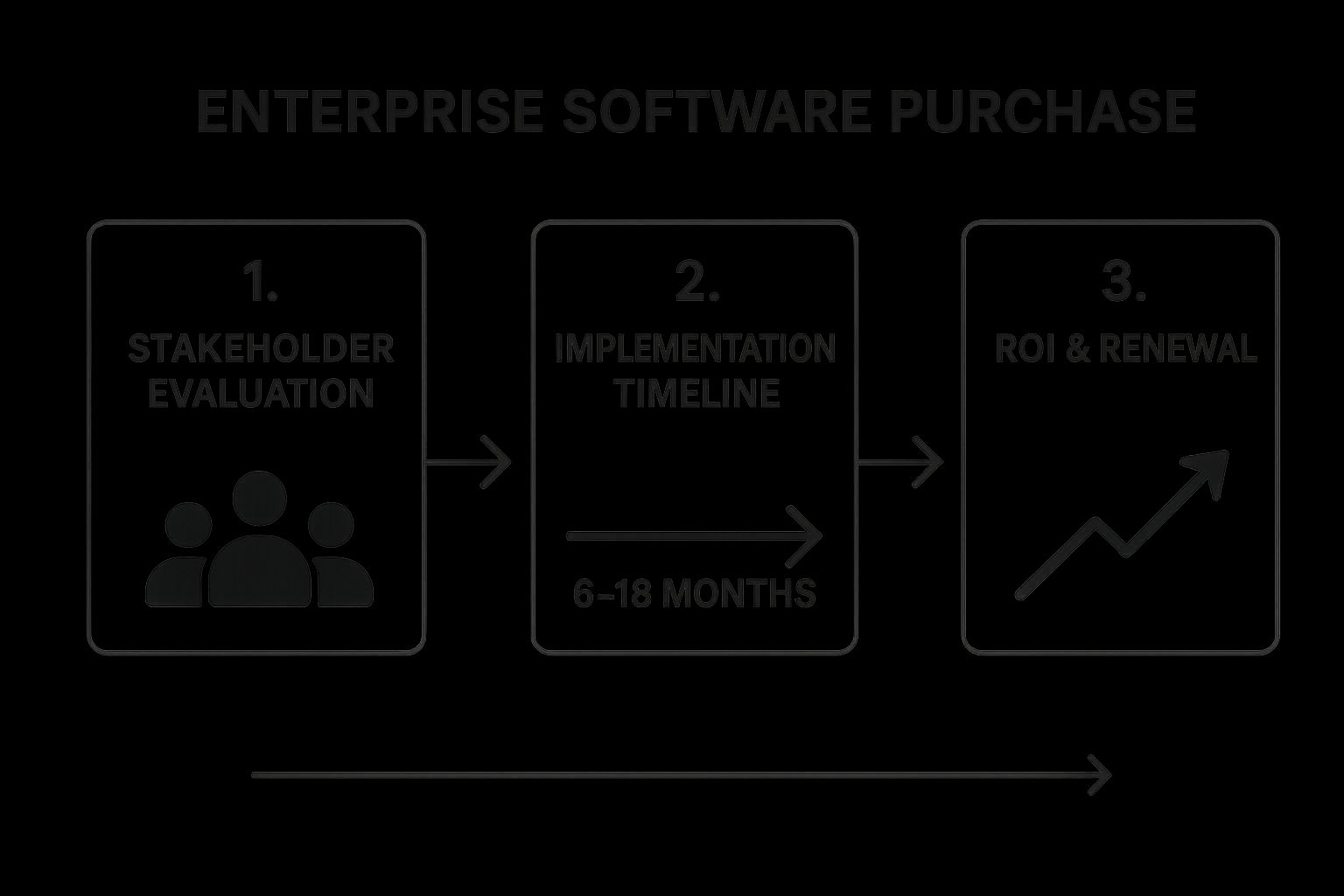Mapping the Path to Customer Delight
Want to improve customer satisfaction and boost conversions? This listicle provides seven practical customer journey mapping examples to guide your UX strategy. See how leading brands like Spotify, Amazon, and IBM use customer journey mapping to optimize the customer experience. We'll analyze B2C and B2B journeys, from simple e-commerce purchases to complex enterprise software implementations. Learn from their successes and identify actionable insights to build your own effective customer journey maps.
1. Spotify's B2C Journey Map
Spotify's customer journey map stands as a prime customer journey mapping example, demonstrating how a company can visualize and understand the user experience from initial awareness to ongoing engagement. This map meticulously tracks how users discover the music streaming service, sign up, and interact with its features across various platforms. It delves into the emotional journey, charting the highs and lows users experience at different touchpoints, from the initial excitement of discovering new music to potential frustrations with content discovery or app functionality. This deep understanding allows Spotify to optimize the user experience and drive business goals, such as converting free users to premium subscribers.

Spotify's approach is particularly effective due to its multi-platform focus, encompassing mobile, desktop, and smart device usage. This comprehensive perspective allows them to ensure a seamless and consistent experience regardless of how the user chooses to access the service. The map also cleverly integrates social sharing aspects, recognizing the vital role social networks play in music discovery and enjoyment. This provides valuable insight into how users share music and interact with the platform within their social circles, highlighting the power of network effects in driving growth. Visualizing the free-to-premium conversion pathway is another key feature, enabling Spotify to identify and optimize the critical steps that lead to higher-value subscriptions.
This customer journey mapping example offers several advantages. It effectively visualizes the transition from free to premium, pinpoints pain points in user onboarding and content discovery, and successfully maps cross-device experience continuity. Furthermore, it integrates the important social aspects of music consumption into the user journey. However, the map primarily focuses on digital touchpoints and might overlook offline influences. It may also not fully address the diverse needs of different user segments with varying musical preferences. Further detail on cancellation and churn pathways would enhance the map's completeness.
Spotify has used this map to achieve tangible improvements. It informed the redesign of their onboarding flow, resulting in higher conversion rates. It also helped identify engagement opportunities, leading to the creation of personalized playlists like Discover Weekly. Even offline-mode features were influenced by pain points identified in the journey map, demonstrating the practical value of this approach.
When and why should businesses use this approach? Customer journey mapping, like Spotify's example, is beneficial for any business aiming to improve customer experience and drive business outcomes. It's particularly useful for businesses operating across multiple platforms or with complex user journeys. By understanding the customer's emotional journey and identifying key touchpoints, businesses can optimize their processes and offerings to better meet customer needs and achieve specific goals like increased conversions or reduced churn.
Tips for implementing a similar approach:
- Map the emotional highs and lows: Identifying moments of delight and frustration provides opportunities for improvement.
- Map both successful journeys and abandonment paths: Understanding why users drop off is crucial for optimizing the entire journey.
- Consider mapping social sharing touchpoints separately: Their unique influence on network effects warrants specific attention.
Spotify's customer journey map deservedly features in numerous UX case studies as an exemplary B2C journey map. It provides valuable lessons for businesses of all sizes looking to leverage customer journey mapping for improved customer experience and business success. While no public link to the actual map exists, its impact on Spotify's product development is well documented and serves as a powerful testament to the value of this customer-centric approach.
2. Amazon's E-commerce Purchase Journey Map
Amazon's e-commerce purchase journey map is a prime example of customer journey mapping in action, showcasing how a deep understanding of the customer experience can drive business success. This map visualizes the entire customer journey, from initial product discovery to post-purchase engagement, encompassing various touchpoints and interactions. It acknowledges multiple entry points, including direct searches, recommendations, and advertisements, and emphasizes the importance of personalization throughout the shopping experience. This comprehensive approach allows Amazon to identify areas for improvement and optimize the customer journey for maximum conversion and satisfaction.

This customer journey mapping example is particularly relevant for businesses in the AE region striving to enhance their online presence and customer experience. By meticulously mapping each stage, from browsing and comparison shopping to checkout, fulfillment, and even returns, Amazon has identified key friction points and implemented innovative solutions. This focus on customer-centricity is echoed in Jeff Bezos's shareholder letters, and the impact of this approach is visible in features like 1-Click purchasing. Learn more about Amazon's E-commerce Purchase Journey Map
Features of Amazon's Journey Map:
- Multi-channel entry point mapping: Tracks customers arriving from various sources, such as direct searches, recommendations, and ads.
- Personalization: Tailors the experience with personalized recommendations and targeted offers throughout the journey.
- Checkout optimization: Streamlines the checkout process, exemplified by the innovative 1-Click purchasing.
- Post-purchase engagement: Extends the journey beyond purchase with features like delivery tracking, reviews, and seamless returns.
- Cross-device continuity: Maintains a consistent experience across multiple devices.
Pros:
- Comprehensive coverage: Addresses pre-purchase, purchase, and post-purchase stages.
- Friction point identification: Effectively pinpoints areas for improvement in the checkout process and beyond.
- Data-driven personalization: Leverages data to create personalized experiences.
- Customer advocacy focus: Maps the process of soliciting customer reviews and fostering advocacy.
Cons:
- Complexity: The comprehensive nature can make it challenging to view holistically.
- Need for sub-maps: Often requires separate maps for different product categories.
- Maintenance: Can become outdated due to frequent platform changes.
Examples of Successful Implementation:
- 1-Click Purchasing: Developed to address checkout friction, significantly simplifying the buying process.
- Recommendation Engine: Informed improvements to cross-selling and upselling strategies.
- Optimized Returns: Enhanced the return process to boost customer satisfaction and loyalty.
Actionable Tips for Your Business:
- Break down complex journeys: Divide complex e-commerce journeys into smaller, manageable micro-journeys for specific tasks.
- Prioritize checkout optimization: Identify and address high-friction points in the checkout process.
- Analyze abandoned carts: Map abandoned cart journeys to understand conversion obstacles.
- Include post-purchase touchpoints: Consider the entire experience, including packaging, delivery, and returns.
Amazon's customer journey mapping approach provides valuable insights for businesses of all sizes. By understanding and optimizing the entire customer experience, you can improve conversion rates, enhance customer satisfaction, and ultimately drive business growth in the competitive AE market. Whether you are a small business looking for scalable contact center solutions or an enterprise IT manager seeking secure telephony deployments, adopting a customer-centric approach like Amazon’s is essential for success. This methodology is equally valuable for contact center supervisors focusing on agent performance, customer support teams aiming for unified multichannel engagement, and organizations in regulated sectors requiring compliance.
3. Airbnb's Travel Service Journey Map
Airbnb's customer journey map stands out as a prime customer journey mapping example because it masterfully tackles the complexities of a two-sided marketplace. It meticulously details the experiences of both hosts and guests, acknowledging that a successful booking relies on the satisfaction of both parties. This approach maps emotional states, expectations, and touchpoints across all stages: from initial search and booking, through the actual stay, and finally, the post-stay review and potential for future interactions. This holistic view allows Airbnb to optimize for both sides of their platform, ensuring a positive experience that fosters trust and encourages repeat business.

This dual-perspective mapping, a key feature of Airbnb’s approach, visually represents the parallel journeys of hosts and guests side-by-side. It highlights crucial trust-building elements at critical decision points, such as secure payment processing and verified user profiles. The map also visually represents the communication touchpoints between hosts and guests, demonstrating how Airbnb facilitates interaction and resolves potential issues. Furthermore, it extends beyond the transactional aspect of the booking, outlining pathways for post-stay relationship development, encouraging repeat bookings and fostering a sense of community. Finally, Airbnb's journey map acknowledges the diverse ways users access their services, integrating both mobile and desktop experiences into the visualization.
This comprehensive approach has yielded demonstrable benefits. For example, it informed the development of Airbnb's robust review system, a cornerstone of trust-building within the platform. It also led to improvements in host-guest communication tools, ensuring smoother interactions and addressing potential conflicts proactively. Additionally, the journey map helped identify opportunities for product extensions like Airbnb Experiences, demonstrating the strategic value of understanding customer needs throughout their journey.
Pros:
- Effectively captures the unique challenges of a two-sided marketplace.
- Identifies critical trust-building moments in the booking process.
- Maps emotional states alongside functional needs.
- Extends beyond the transaction to include relationship-building.
Cons:
- Complexity of mapping two interconnected journeys simultaneously.
- Difficult to represent local market variations in a single map.
- Can overlook organizational touchpoints behind the scenes.
Tips for Applying This Approach:
- For two-sided marketplaces, create parallel journey maps that show interaction points.
- Highlight trust-building elements distinctly in service-based journey maps.
- Include emotional states for both service providers and customers.
- Map journeys for first-time and repeat users separately.
When and Why to Use This Approach: This dual-sided journey mapping approach is particularly relevant for businesses operating in a two-sided marketplace or any platform connecting distinct user groups (e.g., freelancers and clients, buyers and sellers). It's especially valuable for service-based businesses that prioritize trust and relationship building. This methodology allows organizations to understand the nuanced needs and motivations of each user group, enabling targeted improvements across the entire customer experience, ultimately driving growth and enhancing customer loyalty. While this detailed mapping can be complex, the insights gained are invaluable for businesses aiming to optimize both sides of their platform, like Airbnb has successfully demonstrated. This example is particularly relevant for businesses in the AE region experiencing rapid growth in online marketplaces and the sharing economy. It provides a blueprint for establishing trust and fostering positive relationships in this dynamic environment.
4. IDEO's Healthcare Patient Experience Journey Map
This customer journey mapping example demonstrates a powerful application of design thinking within the healthcare sector. IDEO's Healthcare Patient Experience Journey Map offers a detailed visualization of a patient's interactions with the healthcare system, from the first onset of symptoms through diagnosis, treatment, and ultimately, recovery. This method deserves a place on this list because it provides a framework for understanding the complexities and nuances of patient experiences, which are often fraught with anxiety and uncertainty. It goes beyond simply mapping processes and delves into the emotional and informational needs of patients at each stage. This is especially relevant for organizations in the healthcare sector looking to improve patient satisfaction and streamline care delivery.
How it Works:
IDEO's approach focuses on visualizing the patient's emotional journey alongside the clinical one. It maps various touchpoints with healthcare professionals, systems, and processes, including doctors, nurses, administrative staff, insurance providers, and even digital platforms. The map visually represents the flow of information between these entities, highlighting potential bottlenecks and areas where communication breakdowns can occur. It also emphasizes wait times and periods of uncertainty, which can significantly impact a patient’s experience. This methodology helps identify opportunities to reduce patient anxiety, improve care coordination, and enhance the overall healthcare experience.
Features and Benefits:
- Emotional State Tracking: A core feature is the detailed tracking of the patient's emotional state, with a particular focus on identifying anxiety-inducing points along the journey.
- Multi-Stakeholder Touchpoints: The map incorporates interactions with all relevant stakeholders, providing a holistic view of the patient experience.
- Information Flow Visualization: This helps identify where critical information might be lost or delayed, impacting treatment decisions and patient understanding.
- Wait Time and Uncertainty Mapping: This highlights areas where patients might experience prolonged waits or a lack of clarity about next steps, contributing to frustration and anxiety.
- Digital and Physical Touchpoint Integration: Recognizing the increasing role of digital tools in healthcare, the map integrates both physical and digital interactions.
Pros:
- Deeply addresses the emotional aspects of healthcare experiences, a crucial factor often overlooked in traditional process mapping.
- Identifies critical information gaps and communication breakdowns in the patient journey.
- Highlights coordination challenges between departments and providers.
- Effectively maps both clinical and administrative touchpoints, providing a comprehensive overview.
Cons:
- Highly variable depending on the specific medical condition, potentially requiring multiple condition-specific maps.
- Difficult to implement improvements across fragmented healthcare systems.
- Privacy concerns can limit data collection for journey mapping.
Examples of Successful Implementation:
- Mayo Clinic: Used to redesign their outpatient experience.
- Kaiser Permanente: Implemented to improve care coordination.
- Cleveland Clinic: Applied in their patient experience improvement initiatives.
Actionable Tips for Readers:
- Map information flow alongside patient flow: This helps identify communication gaps and ensures patients receive the necessary information at each stage.
- Highlight waiting periods specifically: Waiting significantly impacts patient perception and should be addressed proactively.
- Include family/caregiver experiences: Their journey is often intertwined with the patient's and can provide valuable insights.
- Pay special attention to transitions: Transitions between departments or facilities are particularly vulnerable to communication breakdowns.
When and Why to Use This Approach:
This approach is ideal for healthcare providers, administrators, and anyone working to improve the patient experience. It's particularly valuable when:
- Redesigning clinical pathways or processes.
- Implementing new technologies or digital tools in healthcare.
- Addressing patient complaints or negative feedback.
- Developing patient education materials or communication strategies.
By understanding the patient journey from their perspective, organizations can identify areas for improvement and create a more patient-centered healthcare system. This customer journey mapping example offers a powerful framework for achieving this goal.
5. Starbucks Omnichannel Experience Journey Map
This customer journey mapping example showcases how Starbucks, a global coffeehouse giant, leverages the approach to meticulously craft a seamless and integrated customer experience. The Starbucks Omnichannel Experience Journey Map serves as a prime example of how businesses can effectively connect with customers across multiple touchpoints, blending the digital and physical worlds. It deserves a spot on this list because it demonstrates the power of a well-executed omnichannel strategy, something particularly relevant for businesses in the AE region seeking scalable and unified customer engagement solutions. Learn more about Starbucks Omnichannel Experience Journey Map
This method maps the entire customer journey, from initial awareness and consideration to purchase and post-purchase engagement. It visualizes how customers interact with Starbucks across physical stores, mobile apps, websites, and social media platforms. This holistic view helps identify key interaction points and optimize each for a consistent and personalized experience. It focuses heavily on integrating digital convenience with the in-store “third place” sensory experience Starbucks is known for.
Features and Benefits:
- Integration of Physical and Digital Touchpoints: The map elegantly connects online and offline interactions, allowing Starbucks to track customer behavior and preferences across channels. This is beneficial for businesses looking to provide a unified experience, regardless of how a customer chooses to interact.
- Mobile Order and Payment Pathway Visualization: A key component of the map is visualizing the mobile ordering and payment process, highlighting pain points and opportunities for improvement. This detailed view is crucial for optimizing the digital experience, particularly important in the AE region where mobile penetration is high.
- Loyalty Program Interaction Mapping: The map meticulously tracks customer engagement with the Starbucks Rewards program, revealing how loyalty influences the overall journey. This information is invaluable for designing targeted loyalty programs and maximizing customer lifetime value.
- Personalization Touchpoints Throughout the Journey: The map identifies specific opportunities for personalization at each stage, from customized offers to tailored content. This allows Starbucks to create more meaningful interactions and strengthen customer relationships.
- Social Sharing and Community Engagement Elements: The map incorporates social media interactions, capturing how customers share their Starbucks experiences online and engage with the brand's online community. This is crucial for understanding brand perception and leveraging social channels for marketing and customer service.
Pros:
- Successfully Bridges Online and Offline Experiences: The map effectively connects the digital and physical realms, creating a seamless omnichannel journey.
- Clearly Identifies Cross-Channel Transition Points: It highlights critical moments of transition between channels, enabling Starbucks to optimize these crucial touchpoints.
- Effectively Maps Loyalty Program Engagement Opportunities: The map provides valuable insights into how customers interact with the loyalty program, informing strategies for increased engagement.
- Incorporates Both Functional and Emotional Aspects of the Experience: It considers not only the practical aspects of the journey but also the emotional responses of customers, leading to a more empathetic and customer-centric approach.
Cons:
- Complexity of Representing Various Ordering/Payment Methods: Consolidating various ordering and payment options into a single view can be challenging, requiring careful design and visualization techniques.
- Challenging to Capture Regional Variations in Store Experiences: The map may struggle to capture regional nuances in store layouts, menus, and customer preferences.
- Technology Adoption Differences Across Customer Segments: Varying levels of technology adoption among customer segments can complicate the map and necessitate segmented approaches.
Examples of Successful Implementation:
- Development of Mobile Order & Pay: The journey mapping process directly contributed to the development and optimization of Starbucks' highly successful Mobile Order & Pay feature.
- Rewards Program Digital Integration Strategy: The map informed the digital integration strategy for the Starbucks Rewards program, enhancing its accessibility and effectiveness.
- Store Layout Decisions: The map guided store layout decisions to accommodate mobile order pickup areas and improve the flow of customers within the store.
Tips for Businesses in the AE Region:
- Map Digital-to-Physical Transitions as Critical Moments: Pay special attention to the points where customers transition between online and offline channels.
- Highlight Personalization Opportunities: Identify specific opportunities for personalization at each stage of the journey.
- Include Operational Considerations: Consider operational factors like staffing, inventory management, and technology infrastructure alongside the customer experience.
- Create Separate Journey Maps for Different Ordering Modalities: Developing separate maps for different ordering methods (e.g., in-store, mobile order, delivery) can provide more granular insights.
Starbucks’ customer journey mapping serves as a powerful customer journey mapping example for businesses of all sizes. By understanding and implementing these principles, businesses in the AE region can create truly connected customer experiences that drive loyalty, engagement, and ultimately, business growth. This is especially relevant for our target audience, ranging from small businesses seeking scalable contact center solutions to enterprise IT managers needing robust and compliant telephony deployments.
6. IBM's B2B Enterprise Software Purchase Journey Map
This customer journey mapping example showcases how IBM tackles the intricate process of selling complex enterprise software. Understanding this approach can provide valuable insights for businesses in the AE region, particularly those dealing with lengthy sales cycles and multiple decision-makers. IBM's map meticulously tracks the customer journey from initial evaluation and purchase through implementation, adoption, and ultimately, ROI realization. This model acknowledges the extended timelines (often 6-18 months) and the various touchpoints with different stakeholders involved in enterprise-level decisions. It's particularly relevant for understanding how technical evaluators, end-users, and financial decision-makers interact and influence the buying process.

The infographic visualizes the flow of IBM's B2B customer journey, starting from the initial need identification and moving through solution exploration, vendor evaluation, proof of concept, negotiation, and finally, implementation and ongoing support. It highlights the cyclical nature of the journey, emphasizing the importance of customer success and renewal for long-term growth. The infographic clearly demonstrates the interconnectedness of each stage and the importance of managing each touchpoint effectively.
This method works by meticulously mapping the different stages a customer goes through, identifying the key stakeholders at each point, and pinpointing their specific needs and pain points. For instance, the map recognizes that technical evaluators will have different concerns and require different content than financial decision-makers. By understanding these nuances, IBM can tailor its marketing and sales efforts to effectively address each stakeholder group. This approach goes beyond just securing the initial sale; it emphasizes post-sale implementation, ongoing support, and ultimately, achieving the desired ROI, crucial for enterprise software adoption.
IBM has successfully implemented this journey map to redesign its content marketing strategy for cloud services, informing the development of customer success programs, and guiding sales enablement tools and training. This customer journey mapping example demonstrates how mapping can drive tangible business improvements. For example, understanding content consumption patterns at different stages enabled IBM to create more effective marketing materials.
Pros:
- Effectively captures the complexities of B2B buying committees and influencer roles.
- Maps content needs at different stages of the lengthy buying process.
- Connects pre-sale promises with post-sale implementation reality.
- Identifies opportunities for relationship development beyond the initial transaction.
Cons:
- Extreme complexity can make comprehensive visualization challenging.
- Difficult to represent various industry-specific journeys in a single map.
- Can become too abstract when attempting to represent all stakeholders simultaneously.
Tips for Implementing this Approach:
- Create separate journey maps for different stakeholder types within the buying committee.
- Map content requirements and technical validation needs at each stage.
- Highlight the handoff points between marketing, sales, and customer success teams.
- Include internal processes alongside customer-facing touchpoints.
This approach is particularly valuable for businesses selling complex products or services with extended sales cycles, like enterprise software, cloud solutions, or sophisticated hardware. It's also highly relevant for businesses in the AE region serving enterprise clients, where navigating complex organizational structures and decision-making processes is crucial. By understanding the customer journey thoroughly, businesses can optimize their efforts to better meet customer needs at each stage, leading to increased customer satisfaction, higher conversion rates, and stronger long-term relationships. Learn more about IBM's B2B Enterprise Software Purchase Journey Map
IBM’s approach, popularized by their marketing and customer experience teams and even referenced by former CEO Ginni Rometty, deserves a place on this list because it showcases how to tackle complex B2B sales. It offers a powerful framework for understanding the multifaceted customer journey in the enterprise software market and provides actionable insights for improving engagement and driving successful outcomes. This customer journey mapping example is especially valuable for organizations in the AE region aiming to effectively target enterprise clients and navigate the complexities of B2B sales.
7. Financial Services Mortgage Application Journey Map
A Financial Services Mortgage Application Journey Map is a powerful customer journey mapping example specifically designed to visualize the intricate and often overwhelming process of securing a mortgage. This method meticulously charts the customer's experience from initial research and pre-qualification through application, approval, closing, and even ongoing relationship management. This type of customer journey map is particularly valuable as it focuses on a high-stakes financial decision filled with complex documentation, regulatory hurdles, and inherent customer anxiety. This makes it a highly relevant customer journey mapping example, particularly for organizations operating within the financial services sector.
How it Works:
This journey map breaks down the mortgage process into key stages and touchpoints. It details the customer's actions, thoughts, and emotions at each step, revealing pain points, opportunities for improvement, and crucial moments where targeted intervention can enhance the experience. This includes mapping not only the core application process but also peripheral elements such as financial literacy and educational needs, document gathering, and interactions with third-party partners like realtors and insurance providers. It tracks multi-channel engagement, be it online, phone, or in-person interactions, painting a comprehensive picture of the customer’s journey.
Successful Implementations:
- Quicken Loans: Leveraged journey mapping insights to develop their streamlined “Rocket Mortgage” process, significantly reducing complexity and application time. This is a prime example of how a well-executed customer journey map can lead to disruptive innovation.
- Bank of America: Improved their mortgage application portal based on journey mapping feedback, enhancing user experience and streamlining the digital application process.
- USAA: Created targeted first-time homebuyer resources and support materials after mapping revealed specific needs and anxieties within this customer segment.
Actionable Tips:
- Map educational content needs: Align educational resources with specific process steps to empower customers with the knowledge they need, when they need it.
- Prioritize transparency: Clearly communicate timelines and status updates to manage customer expectations and reduce anxiety.
- Include partner touchpoints: Map interactions with realtors, insurance providers, and inspectors to gain a holistic view of the broader home buying journey.
- Segment your maps: Create separate journey maps for different customer segments (e.g., first-time buyers, refinancing customers) to address specific needs and challenges.
When and Why to Use This Approach:
This approach is especially relevant for financial institutions seeking to improve customer satisfaction, streamline operations, and identify opportunities for digital transformation. It is particularly valuable for:
- Identifying pain points: Uncover bottlenecks and frustrations within the complex documentation and verification process.
- Meeting regulatory requirements: Map compliance checkpoints alongside the customer experience to ensure adherence to regulations while maintaining a positive user experience.
- Enabling digital transformation: Identify opportunities to digitize paper-heavy processes and improve efficiency.
- Building customer trust: Address moments of anxiety with proactive communication and support, fostering confidence and strengthening customer relationships.
Pros:
- Effectively identifies pain points in complex documentation requirements.
- Maps regulatory requirements alongside customer experience.
- Highlights opportunities for digital transformation of paper-heavy processes.
- Identifies moments of anxiety where reassurance is needed.
Cons:
- Regulatory variation by region makes standardization difficult.
- Long timeline (30-90 days) creates challenges in maintaining continuous engagement.
- Different customer segments have vastly different knowledge levels and needs.
Popularized By: Quicken Loans UX Research Team, Financial services design thinking consultancies, Featured in financial technology innovation case studies.
This detailed example of customer journey mapping demonstrates how a complex, high-stakes process can be visualized and optimized to improve customer experience, streamline operations, and drive business success within the financial services industry. This approach is particularly valuable for businesses in the AE region striving to meet the evolving demands of their customers while navigating a complex regulatory landscape.
Customer Journey Mapping Examples Comparison
| Journey Map | Implementation Complexity 🔄 | Resource Requirements 💡 | Expected Outcomes 📊 | Ideal Use Cases 💡 | Key Advantages ⭐ |
|---|---|---|---|---|---|
| Spotify's B2C Journey Map | Moderate complexity: multi-platform, emotional tracking | Moderate: requires UX research and data on emotional states | Improved onboarding and conversion; better user engagement | Digital streaming services focusing on user retention | Visualizes free-to-premium transition; social integration |
| Amazon's E-commerce Purchase Journey Map | High complexity: multiple channels, personalization, post-purchase stages | High: cross-team data, multiple sub-maps often needed | Reduced checkout friction; improved personalization and returns | Large-scale e-commerce platforms | Covers full purchase lifecycle; checkout optimization |
| Airbnb's Travel Service Journey Map | High complexity: dual perspective (hosts & guests) | High: detailed mapping of two user groups | Enhanced trust and communication; improved booking and reviews | Two-sided marketplaces | Highlights trust-building; emotional + functional mapping |
| IDEO's Healthcare Patient Experience Journey Map | Very high complexity: multi-stakeholder, emotional & info flows | High: patient data, organizational coordination | Anxiety reduction; better care coordination and info flow | Healthcare providers and systems | Emphasizes anxiety & waiting; integrates multi-stakeholder touchpoints |
| Starbucks Omnichannel Experience Journey Map | Moderate to high complexity: integrates online & physical touchpoints | Moderate: data from multiple channels and operational inputs | Seamless omnichannel experience; loyalty program growth | Retail & food service with channel blending | Bridges physical & digital; highlights loyalty engagement |
| IBM's B2B Enterprise Software Purchase Journey Map | Very high complexity: long timelines, many stakeholders | Very high: extensive research, multiple stakeholder inputs | Streamlined content marketing; improved sales enablement | Complex B2B, enterprise purchases | Captures multi-stakeholder buying process; links pre/post-sale |
| Financial Services Mortgage Application Journey Map | High complexity: regulatory, documentation, lengthy process | High: multi-channel data, regulatory knowledge | Reduced anxiety; streamlined application; better customer education | Highly regulated financial product applications | Maps regulatory and educational needs; anxiety tracking |
Creating Seamless Customer Journeys
From Spotify's personalized music experience to IBM's complex B2B sales journey, the customer journey mapping examples we've explored demonstrate the power of visualizing the customer experience. These diverse examples highlight how understanding each touchpoint, from initial awareness to long-term loyalty, allows businesses to identify pain points, optimize processes, and ultimately create more valuable interactions. Whether your focus is a streamlined e-commerce checkout (like Amazon) or a complex mortgage application within the financial services industry, customer journey mapping provides a crucial framework for improving UX, boosting conversion rates, and fostering stronger customer relationships.
The most important takeaway is that effective customer journey maps are actionable. They should not only visualize the customer's experience but also reveal clear opportunities for improvement. Gathering feedback is just the first step. For a truly customer-centric approach, it's crucial to analyze and interpret this data effectively. This process, known as voice of customer analysis, helps translate raw customer feedback into meaningful insights that can inform your journey mapping efforts. By combining a deep understanding of your target audience – whether they're individual consumers or enterprise IT managers – with a detailed visualization of their experience, you can create truly exceptional customer journeys. Mastering these concepts allows you to not only meet customer expectations but exceed them, driving business growth and cultivating lasting loyalty in the competitive AE region.
For organizations in regulated sectors like healthcare (as shown by IDEO's example) or finance, where compliance and data security are paramount, understanding the customer journey becomes even more critical. Ultimately, a seamless, personalized, and efficient customer experience is the cornerstone of success in today's dynamic business environment. Start building exceptional customer journeys today with Cloud Move. Our suite of cloud contact center solutions, designed for scalability, security, and multichannel engagement, empowers you to gain a 360° view of your customer interactions, making your journey mapping process even more insightful and effective.




